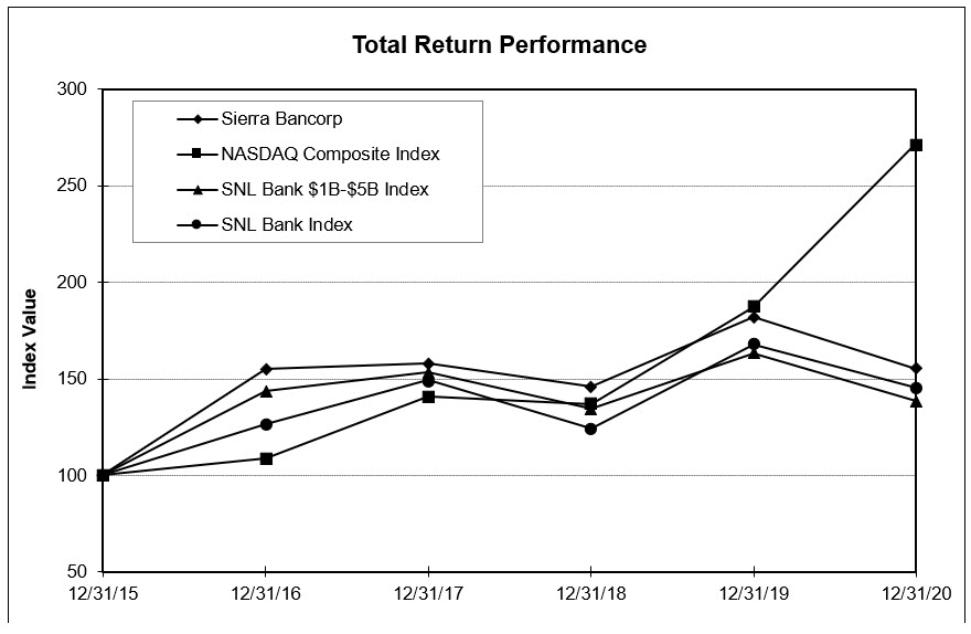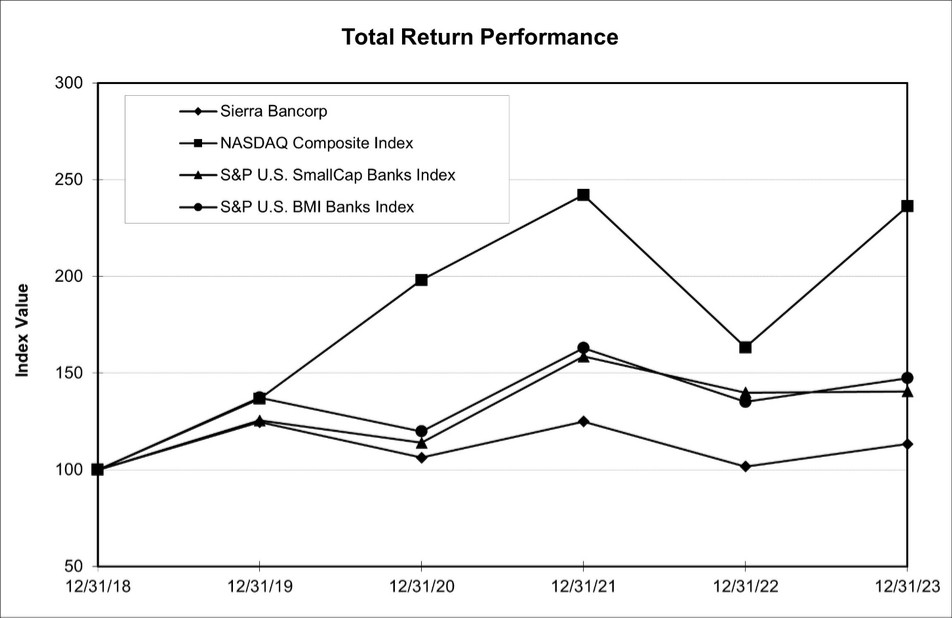Noninterest income improved in 2020 with a2023 decreased $0.4 million or 1% over 2022 and, increased $2.7 million, increase, or 11%, as compared to an increase of $1.9 million, or 9%,10% in 2019.2022 over 2021. Total noninterest income was 0.97%0.89% of average interest-earning assets in 20202023 as compared to a ratio of 1.0%0.95% in 2019 and 0.98% in 2018.2022. The ratio declineddecreased in 2020 due2023 mostly to a 14%an increase in interest-earning assets.assets while noninterest income including service charges on deposit accounts were mostly flat.
The principal component of the Company’s noninterest revenue, service charges on deposit accounts decreased by $1.0 million, or 8%,were flat in 20202023 as compared to 2019. The same line item declined2022, and increased by $0.3$0.8 million, or 2%4%, in 2019 over 2018.2022 as compared to 2021. This line item is primarily driven by the volume of transaction accounts. As a percent of average transaction account balances, service charge income was 1.9%1.4% in 2020,2023, 1.3% in 2022 and 1.0%1.2% in 20192021. This line item consists of a variety of fees including service charges on corporate accounts, treasury management fees, charges on corporate and 2018.consumer accounts including treasury management fees, ATM fees, overdraft income, monthly service charges on certain accounts and debit card interchange. Overdraft income on both consumer and corporate accounts totaled $5.3 million in 2023; $4.6 million (net of restitution) in 2022 and $4.9 million in 2021.
CheckcardDebit card fees (included in service charges on deposit accounts) consists of interchange fees from our customers’ use of debit cards for electronic funds transactions. This category increaseddecreased in 2023 over 2022 by $0.4$0.2 million or 7%,but was relatively flat in 2020 as compared to 2019,2022 and increased by $0.7 million, or 12%,2021. The unfavorable variance in 2019 over 2018. The increases in 2020 and 2019 are primarily2023 was a result of growth in our deposit account base as well as increased usage of debit cards by our customers.
Other service charges and fees declined by $0.1 million, or 3%, in 2020 over 2019, and by $1.0 million, or 19%, in 2019 over 2018. The decrease in 2019, was due largely to two infrequent items occurring in 2018. In 2018, we had a $1.2 million write-up of our investment in Pacific Coast Bankers Bank (“PCBB”), due to Accounting Standards Update 2016-01 which required the Company to write the investment to fair value through earnings, as well as a $0.2 million special dividend received pursuant to our equity investmentbrand change later in the Federal Home Loan Bank of San Francisco (“FHLB”).year from Mastercard to VISA.
BOLI income generally fluctuates based on the market.market due to the Company’s “separate account” BOLI being invested in assets that closely mirror investments choices of deferred compensation participants. There is also a part of BOLI that is “general account” and receives a standard crediting rate from the carrier which remains relatively stable year over year. However, the separate-account BOLI used to offset deferred compensation fluctuates significantly from year-to-year as many of our deferred compensation participants are invested in equity-index style funds. In 2020the comparative years ending 2023 over 2022, BOLI income increased by $0.2 million or 10%, and$2.8 million; however, in 20192022 over 2021, BOLI income increased by $1.6 million, or 270%, over 2018. BOLI income is derived from two types of policies owned by the Company, namely “separate account” and “general account” life insurance, and the year over year variances are due in large part to fluctuations in income on separate account BOLI.decreased $3.6 million. The Company had $9.3$9.9 million invested in separate account BOLI at December 31, 2020, which produces income that helps offset expense accruals for deferred compensation accounts the Company maintains on behalf of certain directors and senior officers. Those accounts have returns pegged to2023. This separate account BOLI closely matched participant-directed investment allocations that can include equity, bond, or real estate indices, and are thus subject to gains or losses which often contribute to significant fluctuations in income (and associated expense accruals). GainsNet gains on separate account BOLI totaled $1.4$0.9 million in 20202023 as compared to $1.2 million in 2019, and net losses of $0.4$2.0 million in 2018.2022 and gains of $1.7 million in 2021. This resulted in a favorable variance of $0.2$2.9 million for 2020the comparative years ending 2023 as compared to 2019,2022 and a favorablean unfavorable variance of $1.6$3.7 million in 2019for the comparative years ending 2022 as compared to 2018.2021. As noted, gains and losses on separate account BOLI are related to expense accruals or reversals associated with participant gains and losses on deferred compensation balances, thus the overall net impact on taxable income tends to be minimal. The Company’s books also reflect a net cash surrender value for general account BOLI of $41.7 million and $43.2 million, atrespectively for the years ending December 31, 2020 as compared to $42.5 million at year-end 2019.2023 and 2022. General account BOLI produces income that is used to help offset expenses associated with executive salary continuation plans, director retirement plans and other employee benefits. Interest credit rates on general account BOLI do not change frequently so the income has typically been fairly consistent with $1.0$0.9 million of general account BOLI income recorded for all three yearsthe year ending December 31, 2020, 2019,2023 and 2018.$1.0 million record for the two ending December 31, 2022 and 2021.
Gain on the sale of fixed assets for $15.3 million for the year ending 2023, was due to the sale of 11 Bank owned branch buildings that were subsequently leased back. This transaction and related gain was part of an overall balance sheet restructuring. The Company recognized a $14.5 million loss for the year ending December 31, 2023 on investment securities intended for sale in December 2023 and subsequently sold in January 2024. This securities strategy identified $196.7 million in bonds yielding 2.61% to be sold in January 2024 at a loss of $14.5 million. The proceeds from the securities strategy went to paydown a portion of other borrowed funds with an average rate of 5.52%. The Company also realized a $0.4 million gain on the sale of investment securities during the year ending December 31, 2023, a $1.5 million gain for the same period in 2020,2022 from a portfolio restructure to decrease effective duration, taking advance of slight rallies in the Treasury market in early and late 2022, as compared to a $0.2 million loss in 2019 andwell as a nominal gain for the same period in 2018. 2021.
The gainother category, decreased $2.8 million to $4.4 million in 20202023 and increased to $7.2 million in 2022 from $2.9 million in 2021. The year over year decrease in 2023 over 2022 was due to a net gain onresult of 2022 events that did not recur in 2023 including $3.6 million from the sale of debt securities, in an effort to restructureother assets, and the portfolio primarily to eliminate small residual balances and reduce potential credit risk on certain municipal holdings. The loss in 2019 was taken in order to sell several small balance and low-yielding bonds in order to replace them with fewer higher-yielding bonds. The earn backrecovery of the transaction was less than a year.
Loss on tax credit investment reflects pass-through expenses associated with our investments in low-income housing tax credit funds and other limited partnerships. Those expenses, which are netted out of revenue, decreased by $0.9 million, or 43%, in 2020 as compared to 2019. In 2019 as compared to 2018, these expenses decreased by $0.5 million, or 19%. The favorable variance in 2020 is due to the expiration of expense amortization on several funds which had reached the end of their useful tax benefit life. The largest contribution to the favorable variance in 2019, as well as the unfavorable variance in 2018 came from a $0.91 million adjustment to accelerate expense amortization on our tax credit investments, to ensure that the book value of each investment does not exceed its projected remaining tax benefits.prior period legal expenses.


